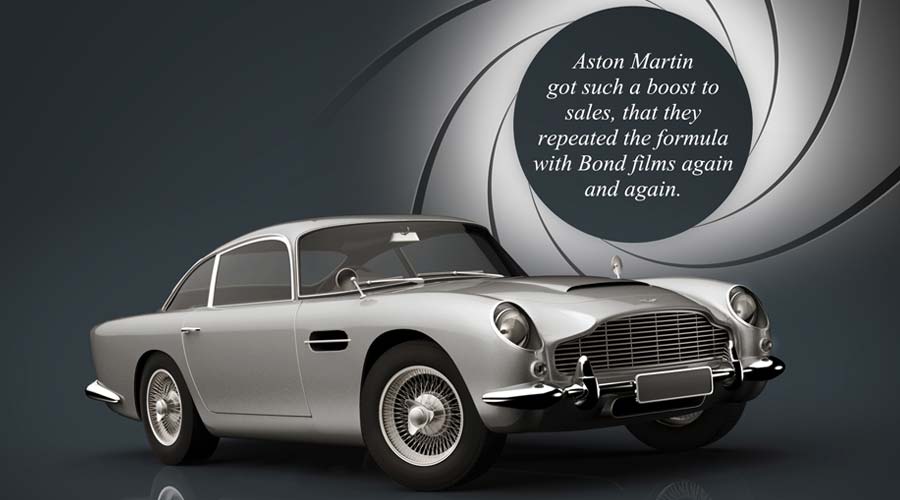



Product placement

Like many people, I first became aware of product placement because of the 1964 movie Goldfinger, in which James Bond drove his now trademark Aston Martin DB5. As the story goes, producers Albert Broccoli and Harry Salzman said to the Aston Martin Company: “Give us a car.” Its reply: “How much will you pay?” Their response: “Nothing, but you’ll get some great publicity.”
This turned out to be very much the case. Aston Martin got such a boost to sales, that they repeated the formula with Bond films again and again; so much so that an upmarket sports car became an essential part of the James Bond brand (could anybody even imagine Bond waiting at a bus-stop in order to confront his arch-baddie?).
By the time 1995 came along with Goldeneye, the secret agent had changed allegiance to BMW. According to The Huffington Reporter, BMW sold 9,000 of the BMW Z3 roadster featured, in the first month of the film’s release. Given that the sales refer to one model in one month and don’t take into account the following years and spin-off publicity for BMW models generally, the “undisclosed” sum that BMW paid the Bond movie folks for product placement could have been well into millions of dollars – and still have been very cheap.
In many ways, product placement in movies has become too common. A good example of rather a lot of product placement was the 2005 Tom Hanks movie Cast Away. When I watched the film, it didn’t seem so much a movie with a story-line, but more like a very long advert for Federal Express parcel delivery and Wilson sporting goods. But it looks like I am in a tiny minority – the film was both a critical and financial success at a budget of US$90 million and with box office receipts of $429.6 million.
Product placement is actually rather old. The generally regarded first product placement in the mass media took place in 1902 in the German magazine Die Woche which had a photograph, but not just any photograph. A countess held a copy of the magazine, making the article simultaneously an advert for the magazine itself. In 1925, the movie The Lost World had an important scene with a Corona typewriter. Products have been gaining market share via movies and television shows regularly ever since.
There are some strange dynamics with product placement. Sometimes they morph into something far from the original. A good example of this is the soap opera – a term coined because Procter & Gamble and Unilever funded radio and TV dramas in the 1930s to 1950s to promote detergents to home-makers. The broadcast times fitted in with the time when women were at home, focusing on housework.
The format was new – half-hour episodes, spread out to one per week. Each episode picked up where the last one left off, and the story line generally didn’t really have much of a direction; it just kept on going. The format lives on today, stronger than ever, yet strangely divorced from anything to do with the detergents that spawned it.